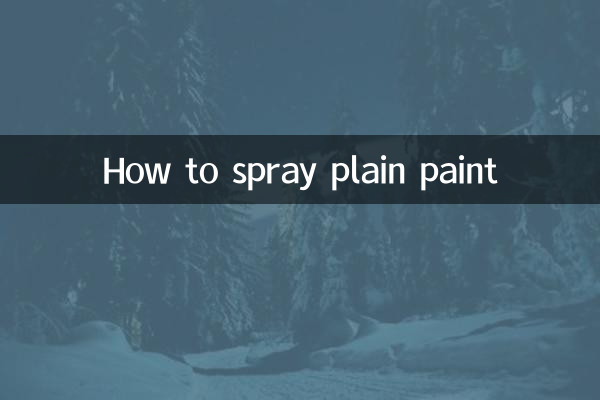How to spray plain paint
Applying plain paint is a common technique in the field of automotive repair and modification. Whether you're repairing scratches or changing the color of your entire vehicle, it's crucial to master correct spray painting techniques. This article will combine the hot topics and hot content on the Internet in the past 10 days to give you a detailed introduction to the steps, precautions and answers to frequently asked questions about spraying plain paint.
1. Basic steps for spraying plain paint

The process of spraying plain paint can be divided into the following steps:
| steps | Operation content | Things to note |
|---|---|---|
| 1. Surface treatment | Clean, polish, degrease | Make sure the surface is free of dust and oil stains |
| 2. Primer spraying | Spray primer to enhance adhesion | Apply topcoat after primer is dry |
| 3. Topcoat spraying | Spray plain paint evenly | Keep gun distance consistent |
| 4. Varnish spraying | Spray varnish protective topcoat | Varnish thickness should be uniform |
| 5. Dry polishing | Natural drying or baking and polishing | Avoid premature polishing |
2. Common problems and solutions when spraying plain paint
According to popular discussions on the Internet in the past 10 days, the following are common problems and solutions when spraying plain paint:
| question | Reason | solution |
|---|---|---|
| Blistering on the paint surface | There is moisture or oil stains on the surface | Clean the surface thoroughly and ensure it is dry |
| Uneven paint surface | Spray gun distance is inconsistent | Keep the distance between the spray gun and the surface 20-30cm |
| cracks in paint | The paint layer is too thick or dries too quickly | Spray in layers, spray after each layer is dry |
| The color difference is obvious | Inaccurate color matching or poor spraying techniques | Use professional color mixing equipment and practice spraying techniques |
3. Selection of tools and materials for spraying plain paint
If a worker wants to do his job well, he must first sharpen his tools. The following are recommended tools and materials needed to spray plain paint:
| Tools/Materials | Recommended brands | function |
|---|---|---|
| airbrush | SATA,Iwata | Spray paint evenly |
| compressed air machine | Ingersoll Rand | Provide stable air pressure |
| sandpaper | 3M | polish surface |
| Plain paint | PPG, BASF | Provides color coverage |
| Varnish | DuPont | Protective topcoat |
4. Environmental requirements for spraying plain paint
The spraying environment has a direct impact on the quality of the paint surface. The following are ideal environmental conditions:
| environmental factors | ideal conditions | influence |
|---|---|---|
| temperature | 20-25°C | Affects paint fluidity and drying speed |
| Humidity | 40-60% | Too high will cause blistering on the paint surface |
| ventilation | Good but no strong winds | Avoid dust accumulation |
| light | Sufficient and even | Easy to observe spraying effect |
5. Sharing tips on spraying plain paint
Based on recent discussions on popular automotive forums, here are the spray painting tips shared by professional technicians:
1.Airbrush moving tips: Keep the spray gun perpendicular to the surface and move in a straight line at a constant speed to avoid arc trajectories.
2.Overlap spraying: Each spray should overlap 50% of the previous spray area to ensure even coverage.
3.Spraying in layers: Thin spraying multiple layers is more effective than thick spraying a single layer. Allow appropriate drying time between each layer.
4.Angle adjustment: For complex curved surfaces, the angle of the spray gun should be adjusted at any time to ensure even distribution of paint.
5.edge processing: Spray the edges first, then the middle area to avoid paint accumulation on the edges.
6. Maintenance suggestions after spraying plain paint
After spraying is completed, proper maintenance can extend the life of the paint:
| time | Maintenance measures | Things to note |
|---|---|---|
| Within 24 hours | Avoid contact with paint | The paint has not yet fully cured |
| Within 1 week | Avoid high-pressure water gun cleaning | The paint is still continuing to cure |
| 1 month later | Can be waxed and polished | Use special car wax |
| long term | Regular cleaning and maintenance | Avoid acidic cleaners |
Through the above detailed step-by-step explanation, problem analysis and skill sharing, I believe you will have a more comprehensive understanding of spraying plain paint. In actual operation, it is recommended to practice on scrap parts first, and then proceed to formal spraying after mastering the skills. Remember, patience and careful preparation are the keys to a perfect finish.

check the details

check the details